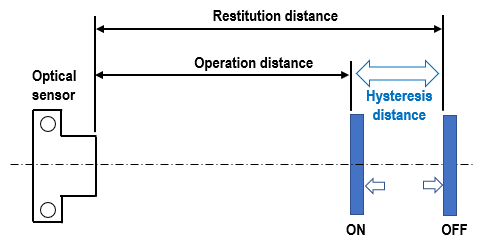What does the hysteresis on the datasheet of the diffuse reflection type Optical Sensor :B5W-DB mean?
ID: FAQE40047E
update:
Answer
In the case of a reflective type photosensor, the difference between the operation distance and the restitution distance is called “hysteresis distance.”
Explanation
In a reflective type photosensor, the operation distance is the distance at which the sensor turns ON when the sensing object approaches the sensor. The restitution difference is the distance at which the sensor turns OFF when the sensing object moves away from the sensor. The difference between the operation distance and the restitution distance is called “hysteresis distance” (see below). Without hysteresis, the phenomenon of ON/OFF repetitions (chattering) occurs around the operation area. To prevent this, hysteresis is required. For B5W-DB, the hysteresis is defined as 30% or less. For example, if an object turned on the sensor at a distance of 800 mm, the restitution distance is 800 mm x 1.3 = 1,040 mm or less.


Quick tips
When using a reflective photosensor, the equipment is typically designed so that the sensing object crosses the sensor in front of the sensor’s sensing surface from left to right or from up to down. However, when detecting an object approaching the sensor from the front, the sensor will not return (OFF) until it is away from the operation distance (ON) by the hysteresis distance.
Such applications require consideration in equipment design with respect to hysteresis distance.
| Product category | Sensors Light Convergent Reflective Sensors/Diffuse Reflective Sensors |
|---|---|
| Classification | Usage, Applications |
| Related keywords |
|